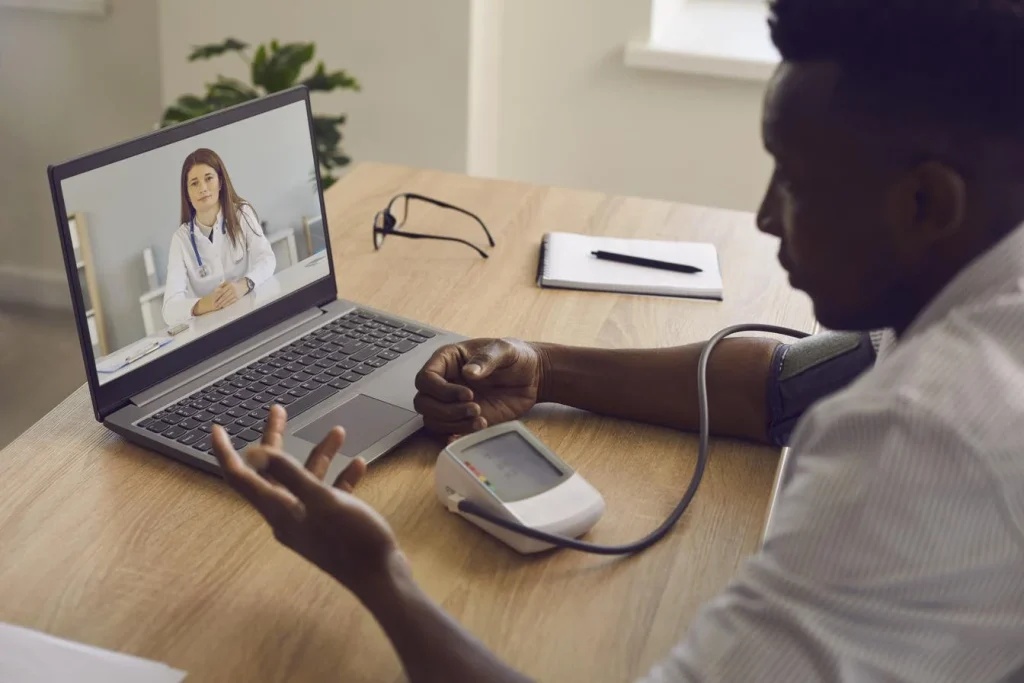Introduction
In today’s rapidly evolving healthcare landscape, Patient remote monitoring has emerged as one of the most impactful innovations. This technology allows healthcare providers to track patients’ health data in real time, ensuring timely interventions and personalized care. Patient remote monitoring is transforming traditional healthcare by bridging the gap between patients and clinicians, offering efficiency, convenience, and improved outcomes. As telemedicine and digital health tools continue to evolve, patient remote monitoring is setting the standard for the future of patient-centered care.
What Is Patient Remote Monitoring?
Patient remote monitoring (PRM) refers to the use of digital technology to collect health data from patients in one location and securely transmit it to healthcare professionals in another. This process enables continuous observation of patients’ vital signs, such as heart rate, blood pressure, glucose levels, and oxygen saturation, without requiring frequent in-person visits. Through patient remote monitoring, healthcare providers can make informed clinical decisions faster, leading to better management of chronic diseases and preventive care.
Reason 1: Enhanced Patient Engagement and Empowerment
Patient remote monitoring fosters active participation from patients in managing their health. By providing access to their own health data, patients gain awareness of their conditions and can take proactive steps toward improvement. When patients regularly track metrics like heart rate or blood sugar levels, they are more likely to adhere to treatment plans and lifestyle recommendations. This increased engagement not only enhances outcomes but also strengthens the partnership between patients and healthcare providers.
Reason 2: Real-Time Data for Accurate Clinical Decisions
Traditional healthcare models rely on periodic visits, where crucial health changes might go unnoticed between appointments. Patient remote monitoring eliminates this issue by providing real-time data that enables prompt intervention. Physicians can quickly identify abnormalities and adjust treatments before conditions worsen. This continuous flow of information ensures better decision-making and reduces the chances of medical emergencies.
Reason 3: Improved Chronic Disease Management
Chronic diseases such as diabetes, hypertension, and heart failure require consistent monitoring. Patient remote monitoring provides healthcare teams with constant access to patient health metrics, allowing for early detection of complications. Through PRM, clinicians can adjust medications, offer personalized advice, and prevent hospitalizations. This approach not only improves the patient’s quality of life but also reduces the long-term costs associated with managing chronic illnesses.
Reason 4: Reduction in Hospital Readmissions
One of the most significant benefits of patient remote monitoring is the reduction of hospital readmissions. By keeping track of a patient’s condition remotely, clinicians can identify early warning signs of deterioration. This allows for quick intervention through teleconsultations or medication adjustments. Hospitals and healthcare organizations benefit from lower readmission rates, while patients enjoy continuous support from the comfort of their homes.
Reason 5: Cost-Effective Healthcare Delivery
Patient remote monitoring is a cost-efficient solution for both providers and patients. It minimizes unnecessary hospital visits, reduces travel expenses, and saves time for patients. Healthcare institutions can manage more patients with fewer resources, making care delivery more efficient. Insurance companies and healthcare systems are increasingly recognizing the cost-saving potential of patient remote monitoring, making it a sustainable solution for the future of healthcare.
Reason 6: Greater Access to Care in Remote Areas
Geographical barriers have always posed challenges to healthcare accessibility, especially in rural regions. Patient remote monitoring bridges this gap by enabling patients to receive consistent medical supervision without visiting a clinic or hospital. With PRM, individuals in underserved or remote areas can enjoy the same quality of care as urban patients, ensuring equity and inclusivity in the healthcare system.

Reason 7: Increased Efficiency for Healthcare Providers
By integrating patient remote monitoring into their workflows, healthcare providers can streamline operations and prioritize patients based on urgency. Automated data collection and analysis tools reduce administrative burdens, allowing clinicians to focus more on patient care rather than paperwork. The efficiency gained through patient remote monitoring translates to better service delivery, shorter wait times, and higher patient satisfaction.
Reason 8: Early Detection and Prevention of Health Issues
Preventive healthcare is becoming increasingly important, and patient remote monitoring plays a vital role in early detection. Continuous tracking allows healthcare professionals to identify subtle changes in health patterns before they become serious problems. Early detection through PRM reduces hospitalizations, prevents complications, and promotes long-term wellness by enabling timely preventive measures.
Reason 9: Enhanced Patient-Provider Communication
Patient remote monitoring strengthens communication between patients and providers. With access to accurate, up-to-date data, healthcare teams can communicate more effectively and make informed recommendations. Patients, in turn, feel more connected to their care providers, fostering trust and long-term engagement. This improved communication leads to higher treatment adherence and better overall health outcomes.
Reason 10: The Future of Personalized and Predictive Healthcare
Patient remote monitoring is paving the way for a more personalized approach to medicine. The vast amount of health data collected through PRM can be analyzed using artificial intelligence and predictive analytics to tailor care plans for each individual. Future healthcare systems will rely heavily on such technologies to predict potential health risks and design preventive strategies. With the rise of wearable devices, mobile health apps, and smart medical sensors, patient remote monitoring is becoming the cornerstone of next-generation healthcare.
The Role of Advanced Health Care in Patient Remote Monitoring
Advanced Health Care is at the forefront of integrating patient remote monitoring into modern medical practices. Through innovative technologies and data-driven solutions, Advanced Health Care ensures patients receive personalized, efficient, and accessible medical support. The organization’s commitment to enhancing patient outcomes through remote monitoring demonstrates how technology can redefine healthcare delivery.
Challenges and the Path Forward
While the advantages of patient remote monitoring are clear, challenges such as data security, privacy, and interoperability must be addressed. Ensuring compliance with healthcare regulations like HIPAA is crucial to maintaining patient trust. Moreover, training healthcare professionals to interpret remote data effectively is essential. As these challenges are met with technological advancements, patient remote monitoring will continue to evolve and expand across all healthcare sectors.
Conclusion
Patient remote monitoring is revolutionizing healthcare by connecting patients and providers in real time, reducing costs, and improving clinical outcomes. From chronic disease management to preventive care, its benefits are reshaping how medicine is delivered. As technology continues to advance, patient remote monitoring will become an integral part of global healthcare systems, promoting accessibility, efficiency, and personalization. Advanced Health Care’s adoption of innovative remote monitoring solutions is a testament to how this technology will continue to shape the future of medicine. Now is the time for healthcare providers, policymakers, and patients to embrace this digital transformation and move toward a more connected, data-driven future of care.
Your journey begins on our homepage—check it out today.
Frequently Asked Questions
1. What is patient remote monitoring and how does it work?
Patient remote monitoring involves using digital tools to track a patient’s health data and transmit it to healthcare providers. This allows doctors to monitor conditions in real time without the need for frequent hospital visits.
2. What are the main benefits of patient remote monitoring?
The main benefits include improved patient engagement, real-time data collection, cost savings, better chronic disease management, and reduced hospital readmissions.
3. Is patient remote monitoring secure and private?
Yes, patient remote monitoring systems use encrypted communication and comply with healthcare data protection laws to ensure patient privacy and data security.
4. Who can benefit most from patient remote monitoring?
Patients with chronic conditions such as diabetes, heart disease, and hypertension benefit greatly, as do elderly individuals and those living in remote areas with limited access to healthcare.
